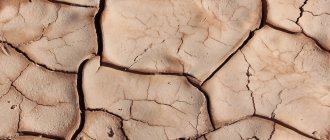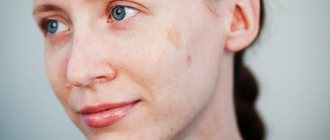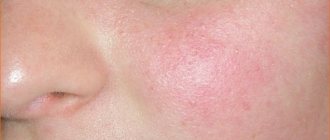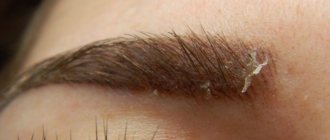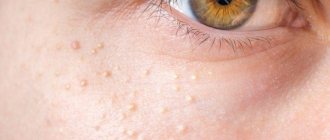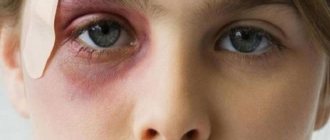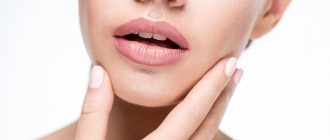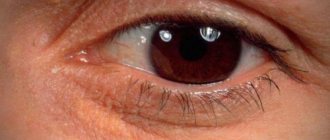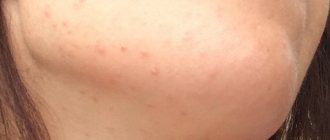A common reason for visiting dermatologists is red spots on the chin, which flake and often cause discomfort to the patient. It is possible that a person is not bothered by unpleasant sensations, but his appearance deteriorates, causing psychological stress and a number of other problems. Therefore, the problem of flaky skin needs to be dealt with, and the sooner treatment is started, the easier and faster it will be to get rid of red spots. What treatment methods exist, and which ones are the most effective?
Why does the skin peel and red spots appear on the chin?
Spots on the chin are a signal from the body about the presence of pathologies or the disturbed course of any process. Before proceeding to neutralize an aesthetic problem, it is necessary to identify the nature of its formation. In this matter, you cannot do without the help of a specialist - a dermatologist, who, in turn, can prescribe a number of additional examinations from an endocrinologist, gastroenterologist, etc.
Attention! The most striking manifestation of allergies is eczema. These are wet or dry spots, the touch of which causes pain. It is better not to touch such stains with your hands, and only professional medical help will help get rid of them.
The most common causes of a rough chin:
- Allergic reactions and irritations (allergens include plant pollen, medications, citrus fruits, household chemicals, etc.);
- Disturbed functioning of the gastrointestinal tract;
- Lack of vitamins and microelements (vitamins A, B, E play an important role in the functioning of the surface layers of the skin);
- Hypovitaminosis;
- Hormonal surge;
- Infectious diseases and immunodeficiencies;
- Deviations in the functioning of the endocrine system;
- Dermatitis, eczema, psoriasis and other dermatological diseases.
However, the reason for the formation of a crust on the chin is not necessarily medical in nature:
- Unsuitable cosmetics and hygiene products;
- Frosty or hot weather;
- Stress and emotional tension;
- Changes in climatic conditions;
- Bad habits;
- Poor nutrition;
- Hereditary factor;
- Failure to comply or improper adherence to personal hygiene rules.
Important! The cause of redness and itching is often a fungus. If it is not eliminated in time, the disease will enter the chronic phase and worsen the quality of life.
So, there are many potential causes of peeling epidermis. Moreover, they are all of a different nature and require mandatory qualified consultation.
Mycosis of the skin in the area of beard and mustache growth and under the beard
Peeling beard skin is one of the types of mycosis, a disease the occurrence of which is provoked by a fungal infection. As a rule, the pathogens are fungi such as Mentagophytes and Verrucosum.
There are a number of pathogens belonging to the zoophilic group; they more often affect people who live in rural areas and also often come into contact with animals.
Reasons for development
A flaky skin surface can occur for a variety of reasons. Experts divide them into external and internal ones.
External reasons:
- a frequently performed shaving procedure, when after washing with tap water, there is a tightening of the skin, a violation of the acid-base balance of the dermis;
- the use of aggressive compounds (lotions containing alcohol);
- washing with soap, whose alkaline structure washes away the fatty layer that protects the skin from pathogens and retains moisture;
- the use of cheap, low-quality cosmetics, which provoke the development of allergic reactions and irritation;
- the influence of negative environmental factors on the human body (wind, heat, frost, dust, air-conditioned air).
Internal reasons:
- pathologies of the nervous and endocrine systems;
- diseases of the liver, gastrointestinal tract;
- frequent stress;
- chronic fatigue;
- lack of sleep;
- exposure to viruses, subcutaneous mites, fungal infections;
- dermatitis, eczema, psoriasis, seborrhea;
- allergic manifestations;
- hereditary diseases (ichthyosis, dry skin type).
We recommend reading: Beard care kit
Clinical picture
Most of the reasons that provoke the occurrence of this problem can be easily treated on their own, but with some of them it is necessary to contact a specialist.
The clinical picture of mycosis is as follows:
- symmetrical arrangement of rashes affecting the chin, neck, lower cheeks;
- the formation of bluish, sharply limited nodes with an elastic structure;
- the surface of the nodes is covered with pustules, which can merge, forming areas of extensive abscess;
- after opening them, you can find the discharge of pus, which becomes covered with crusts;
- the hairs that grow in the affected area are characterized by increased fragility, they are easily pulled out and fall out;
- pain of nodal joints is low;
- Sometimes you can notice the appearance of rounded erythema, with peeling of the skin in the affected area.
Diagnostic methods
Only laboratory diagnostics can help determine the root cause of this condition. It includes:
- microscopy of scrapings from the epidermis, scalp;
- sowing material in special media, the purpose of which is to identify the fungal culture;
- blood biochemistry;
- test for syphilis.
To make a correct diagnosis, it is necessary to conduct an examination using a Wood's lamp. When the cover is affected by mycotic formations, under the rays these are lamps, it turns greenish, which clearly distinguishes it from the background of other, unaffected cover.
Treatment of fungal infections of the epidermis requires the prescription of special drugs, which ones are decided by the specialist, based on the results of the studies, as well as the specific type of pathogen.
You should take the medications prescribed by your doctor for the entire period until new tests show the complete absence of pathogens. Hairs that grow in the affected area must be carefully removed by cutting or treating with tweezers. Extensive abscesses are opened with mandatory disinfection of the skin with Chlorhexidine and other antiseptics that contain it.
Treatment with traditional methods
The most popular substance used to treat mycoses is zinc . However, there are a number of traditional medicine methods that are no less effective.
- Beetroot broth mixed with a little honey. They lubricate the epidermis, leaving it to act for 30 minutes.
- Mix a small amount of sulfur with vegetable oil. Rub the resulting pulp into the cover, three times a day. Remove after an hour using a dry cloth; no need to moisten it with water.
- Brew one part horsetail, two parts celandine and four parts string. Make lotions.
- Boil fish broth from an unpeeled carcass, take 200 g. Squeeze 3 cloves of garlic there, add 100 grams of melted fat. Rub in before bed and rinse off in the morning.
We recommend reading: Van Dyke Beard
Prognosis and prevention
Experts give good prognoses regarding timely initiation of therapy.
Prevention of the disease includes eliminating those factors that provoke the problem:
- prohibition on picking up stray animals, dogs, cats;
- if you suspect that the animal is affected by a fungal infection, be sure to isolate it and immediately seek help from a veterinarian;
- It is forbidden to use other people's shaving equipment or personal hygiene items;
- when there is a person suffering from mycosis in the crowbar, you need to make sure that no one else uses his personal hyena items.
When should you see a doctor?
In medicine, this phenomenon is called “perioral dermatitis” - redness of the dermis, characterized by localized peeling on the chin and around the mouth. Initially, many small bubbles form, which then begin to itch and peel.
If a red spot appears on your chin, you need to exclude the allergen. Often these are cosmetics containing sodium sulfate, paraffin, petroleum jelly or fragrances. If the stain does not disappear, but, on the contrary, from a single rash has spread to the folds of the mouth and nasolabial triangle, you should immediately consult a doctor.
A dermatologist treats this problem. First, a visual examination is carried out, and then a histological analysis of the skin is prescribed (for this, a scraping is taken from the damaged area of the dermis).
Attention! Peeling skin on the chin is the exfoliation of dead keratinized cells from the top layer - the epidermis. This indicates a disruption in the process of replacing old cells with new ones. The size and appearance of peeling indicate its type: pityriasis, scaly, small- and large-lamellar.
In the photo you can see how isolated red spots initially appeared on the chin. In this case, peeling may have a heterogeneous texture and color (from white to bright red). Also, dryness is sometimes preceded by purulent and watery formations, painless nodes under the skin and local pigmentation. The photo shows that there is a clear boundary between healthy dermis and flaky dermis. Lack of timely treatment leads to the spread of peeling to the forehead, cheeks and nose.
Causes of a rash on a woman’s chin
If a small rash appears localized on the chin during the premenstrual period, and disappears after a few days, then this is not a pathology. This is how monthly changes in the hormonal system operate, which are considered normal.
But all other cases of rash outbreaks should be the reason for a full examination by doctors - most likely this is how the body “screams” about internal diseases.
In medicine, there are several main reasons that lead to the problem under consideration:
- Weak immunity . This may be due to protracted chronic diseases (severe and frequent exacerbations), recent surgical interventions and injuries, constant stress, insufficient intake of nutrients into the body, impaired drinking, vitamin deficiency or hypervitaminosis.
- It is the skin that primarily reacts to a weakened immune system, so the rash may appear not only on the chin.
- Frequent colds and hypothermia . These factors lead not only to decreased immunity, but also to malfunction of the sebaceous glands. There is an excessive production of their secretion, which simply clogs the ducts - this is how a rash is formed.
- And since these sebaceous glands are simply in abundance on the chin, this part of the face will react primarily to provocation.
- Diseases of the gastrointestinal tract . Any disturbances in the functionality of the digestive system lead to the accumulation of toxins in the body and the first place where they move is the skin. Therefore, a rash on the chin may indicate problems with the stomach or liver, intestines or gall bladder. Moreover, a woman may not even understand that a pathology is developing in her body.
- Improper functioning of the endocrine system . Medical studies and scientific experiments have proven that there is a direct connection between diseases of the ovaries and pituitary gland and a rash on a woman’s chin. Dysfunctionality of these organs leads to excessive production of estrogen and testosterone, and the consequence of this will be increased secretion production by the sebaceous glands.
In addition, the cause of a rash on a woman’s chin can be an unbalanced diet - a predominance of fatty, smoked, spicy, pickled foods, baked goods and confectionery in the menu. And this provoking factor more often than others leads to the emergence of the problem under consideration.
The cause of a rash on the chin can be the use of low-quality decorative cosmetics and inappropriate care products, an unstable psycho-emotional background and poor ecology in the woman’s place of residence. To accurately determine the provoking factor, you need to consult a doctor who will immediately give clinical recommendations and, if necessary, prescribe medication.
We recommend reading the article about ozone therapy for the face. From it you will learn about the essence of the procedure, indications and contraindications for its implementation, as well as the method of implementation depending on the problem area.
And here is more information about autohemotherapy for acne.
How to eliminate peeling skin?
Red spots on the chin require immediate medical attention. But greater effect can be achieved with an integrated approach to solving this problem. For this purpose, medications, cosmetic procedures and home recipes are used.
Cosmetic procedures
If the cause of redness and peeling on the chin is not a dermatological disease, special procedures will solve the problem. Their goal is to moisturize the epithelium and cleanse dead cells.
- Mesotherapy. The method is based on subcutaneous injections of hyaluronic acid and various meso-cocktails. The procedure will not only relieve the existing syndrome, but also rejuvenate the skin. The technique is good with a minimal list of contraindications and the ability to select any drug.
- Peeling. Chemical cleansing of the face (and body) using fruit and lactic acids. Not suitable for thin and sensitive skin. However, those who are recommended for this procedure can be confident in the quick and painless cleansing of problem areas.
- Biorevitalization. A procedure similar to mesotherapy, which also involves the injection of medications. It is characterized by localized action and the introduction of nucleotides and other biologically active substances.
- Complex techniques for enhanced skin hydration. Facial treatment involves the use of several intensive products at once: tonics, gels, concentrates with active moisturizers (amino acids, enzymes, alginates.
Pharmacy products
When dry skin on the chin is caused by internal causes, medications are prescribed to eliminate the provoking factor. In the fight against dermatitis, regular use of such products is often sufficient. The most effective of them:
- "Lokoid", "Hydrocortisone", "Cortiderm" are corticosteroids used to treat non-infectious diseases. Antibiotic additives of these ointments actively affect the foci of the disease, preventing the development of peeling, and reduce the functioning of the sebaceous glands;
- "Triderm", "Triacutan" - combined ointments based on corticosteroids with the addition of antibacterial additives;
- “Bepanten” - heals cracks and wounds, moisturizes, relieves irritation;
- "Lactofiltrum" - used as an addition to antihistamines. Its main role is to remove toxins;
- "Aquaphor" is a humidifier based on petrolatum. For treatment, you need to cover your chin with a thick layer and do not wash it off. Course of therapy – 14 days;
- "Dexpanthenol" - an anti-inflammatory cream promotes active cell regeneration and accelerates cellular metabolism. Removes red dots on the chin; if there is severe peeling, you can apply it several times a day until a positive effect appears.
Also, pharmaceutical preparations such as zinc ointment, “Losterin”, “Ekolom”, “Gista N”, “Radevit” have proven themselves.
Attention! The body gets used to most anti-allergy medications, which is why their effect weakens. Therefore, after 2 weeks of treatment, it is recommended to change the drug.
We use folk recipes
You can get rid of redness and peeling of the chin at home. Proven folk remedies will help with this:
- Lotions. A cloth or cotton pad is moistened in a strong herbal decoction (with chamomile, string, calendula) and applied to the chin for 15 minutes. You can repeat the procedure up to 5 times a day;
- Compresses. Honey, onion juice and flaxseed oil have proven themselves well. Heat the butter and honey in equal proportions over low heat, add onion juice (1:4). The cloth is moistened and applied to the affected area for 15-20 minutes 3-4 times a day. Other oils are also suitable for this procedure: olive, almond, amaranth, as well as essential oils (lavender, rose, neroli);
- Lotions. Chamomile and green tea have proven themselves as soothing and anti-inflammatory agents. Just pour boiling water over the dried flowers and let it brew for 30 minutes. in a closed container and wipe the flaky and reddened chin;
- Masks. Nourishing mask of 2 yolks, 0.5 tbsp. l. honey and 2 tbsp. l. vegetable oil is slightly heated and warmly applied to the face. After rinsing, apply a nourishing or moisturizing cream. To prepare masks, use cottage cheese, sour cream, and potatoes.
- Scrubs. Ground rolled oats with honey, egg yolk and olive oil are mixed and a homogeneous mass is applied with massage movements, after 10-15 minutes, washed off with warm water. You can remove peeling using salt, soda, and egg-nut scrubs.
If the skin on the chin is peeling and red spots are tormenting you, thermal water, infusion of birch buds, and glycerin masks will help relieve symptoms.
What to do to prevent relapses
- To maintain healthy skin, it is very important to lead a healthy lifestyle, eat well and rest. If necessary, take a course of vitamins in the spring to maintain immunity. Limit alcohol consumption.
- To avoid the reappearance of dry facial skin and flaking, you need to avoid washing with soap. You can buy soft gel cleansers that contain moisturizing ingredients.
- To refresh and moisturize the skin, it is recommended to wipe it with cotton pads soaked in tea. At night, you can apply a thin layer of natural oil - peach or almond. These products moisturize and nourish the skin and fight signs of aging.
- With age, the skin becomes drier and looser. For older men, emphasis should be placed on quality and regular care.
- In winter, you should protect your skin from frost using special creams that form a protective film and prevent moisture evaporation. They are applied to the face 30 minutes before going outside.
- It is very important to drink enough fluids and keep your skin moisturized. For these purposes, you can use sprays with thermal water. In summer, it is necessary to protect the skin from sun exposure using creams with an ultraviolet filter. This will protect your face from premature aging.
- Carry out the shaving process correctly.
The razor should be sharp so as not to irritate the skin
Mesotherapy and biorevitalization are widely used to maintain healthy skin in men
Properly selected preventive measures will allow you to organize proper facial skin care. By following a diet, avoiding stressful situations and leading a healthy lifestyle, you will maintain youthful and healthy skin for a long time.
- Author: Tatyana Vnuchenkova
A frequent reason for visiting a dermatologist or cosmetologist is severe peeling of the skin, which cannot be eliminated by creams, masks, or lotions. All home methods are ineffective, and care products further aggravate the unpleasant symptoms. What causes the skin on the chin to peel? The reason for this is many pathologies, including those of an endocrine nature, each requiring specific treatment.
What the average person calls flaking is actually a peeling layer of dead cells of the superficial layer - the epidermis. This is a characteristic sign of developing disorders in the process of replacing old cells with new ones. Depending on the type and size of the cell, peeling is distinguished as scaly, pityriasis-like, large- and small-lamellar.
In most cases, dry skin occurs on the face (forehead, chin), and extremities (arms, elbows).
Measures to prevent peeling and redness
“Forewarned is forearmed” - this ironclad rule also applies to skin care. After all, it is easier to prevent unwanted peeling than to deal with the consequences. The main preventive measures are:
- Use of high-quality hypoallergenic cosmetics;
- Proper hygiene;
- Use of sunscreens in direct contact with UV rays;
- Regular examinations and timely treatment of identified diseases;
- The use of gels and aftershave foams;
- Avoiding alcohol-containing cosmetics (instead, it is better to choose products containing oils);
- Remove makeup before bed and heavy physical activity.
If your skin is dry, it needs to be regularly moisturized with special care products.
Attention! If the causes of peeling skin on the chin are caused by allergies, you need to immediately remove the allergen; Pregnancy can also cause excessive dryness of the chin in women.
Dermatitis on the chin in women
Dermatitis often occurs on the chin in women because this area is very sensitive to external influences, and internal organs also project their problems onto the skin of this area. Rashes can have a different character, depending on their culprit.
Atopic
Atopic dermatitis, characterized by dry skin, itching, and redness, can occur during a stressful period, a cold, or pregnancy. But these are all provoking factors. And the main reason is a tendency to allergies. Intolerance can be of various types, most often the culprit is poor nutrition. We are not talking about sweets or fatty foods, but foods that a woman should not eat at all. These may be fruits or nuts that are healthy for most other people.
Success in the treatment of atopic dermatitis largely depends on diet.
Contact
Contact dermatitis manifests itself:
- dryness,
- cracks,
- redness,
- swelling,
- rash in the form of blisters,
- in severe cases, erosive changes on the surface of the epidermis, pain,
- previous signs may be supplemented by a general deterioration in health and elevated temperature.
The malaise fully lives up to its name, arising as a response to contact with a substance intolerable to the body. The culprits of rashes are cosmetics, other household chemicals, fabric, jewelry that the skin of the chin comes into contact with. One of the elements of treatment should be the avoidance of a substance that is rejected by the body.
Allergic
Allergic dermatitis can occur regardless of whether the skin has touched a substance intolerant to the body. Sometimes it is enough to stay in the open sun or cold for a short time, inhale the aroma of a flower along with pollen, so that rashes appear on the lower part of the face.
Allergic dermatitis can also be provoked by foods, cosmetics, and medications. When substances that are not accepted by the body get inside, the immune system begins to fight them, resulting in redness, a small rash, and swelling on the chin. They should be combated, including by eliminating the allergen from the patient’s everyday life. But it must first be identified.
Recommendations from cosmetologists
To prevent red spots on the chin from bothering you, cosmetologists recommend:
- Do not use antibacterial soap for washing, which causes dryness and tightness of the skin. It is being replaced by a cleansing gel without propylene glycol and sodium lauryl sulfate;
- If the skin itches, cosmetic oil based on flax seeds will help (it will help eliminate red spots on the chin and soften areas that are flaking);
- Apply day cream with oil components daily. When choosing a cream, it is important to consider the time of year and choose a protective agent against low or, conversely, high temperatures. The cream will create a protective film and prevent moisture from evaporating.
Did you know? Ordinary liquid honey, diluted with a small amount of warm water, will soften the face and eliminate flaking. It is enough to massage the skin with your fingertips and wash with clean water.
Causes of peeling facial skin in men
The reasons can be external and internal. It should be remembered that if peeling appears periodically, is temporary and is relieved by changing products and methods of care, then the problem can be dealt with at home . As a rule, it is caused by external reasons.
External
- Frequent shaving. The condition of the skin is greatly influenced by impurities contained in water. Often after washing, the face feels tight and the skin becomes dry and sensitive. The impact of the razor is additionally traumatic, and the alcohol contained in lotions increases the dryness of the skin.
- Washing with soap. The alkali contained in soap washes away the upper fatty layer of the skin, which protects it from harmful bacteria and retains moisture on the surface.
- Poor quality cosmetics. Cheap cosmetics from unknown manufacturers may contain harmful substances that negatively affect the condition of the skin. They cause irritation and even allergies.
Photos of red spots and peeling on the chin
In the photographs you can clearly observe the progression of dermatitis from the initial stage to its active phase. This state of affairs indicates untimely treatment or an incorrectly selected treatment program.
Red spots on the chin lead to growth and occupy more areas. In this case, papules and pimples may be observed. Confusing dermatitis, eczema and other diseases with acne, many “intensify” their usual hygiene methods: they often begin to wash their faces with inappropriate products and use all kinds of acne remedies. Often, such measures worsen the situation and threaten consequences in the form of dark spots on the skin or a clear separation of healthy skin from damaged skin.
Treatment options if skin is flaky and itchy
- If skin problems are associated with internal pathologies (diseases of the gastrointestinal tract, diseases of the endocrine system), mycosis (fungal disease), hormonal imbalance, the doctor will prescribe a course of medication. It is very important to adhere to the recommended diet and lead a healthy lifestyle.
- For allergic manifestations, a course of antihistamines and a hypoallergenic diet are prescribed. In this case, as well as with dermatitis, psoriasis or eczema, much attention is paid to the correct choice of facial skin care products. It is recommended to avoid creams and ointments containing fragrances, preservatives and lanolin. Alcohol-based lotions greatly increase dryness and flaking. Also in such cases, the following medications are used to treat damaged skin: ointments and creams based on dexpanthenol, hormonal agents, pharmaceutical masks with aquaphor and hydrocortisone to moisturize the skin. They are used in short courses and only on the recommendation of a doctor.
Dexpanthenol is much cheaper than Bepanten
Peeling skin on the chin - causes
Dry skin can indicate a wide variety of disorders in the functioning of the whole body. Factors contributing to the development of these pathologies can be: exposure to chemicals, excessive exposure to the sun or solarium, infectious processes (bacterial, fungal, viral, etc.).
Often the cause is an autoimmune disease, when the cells of the defense system act against the host body. Lack of vitamins A and E, allergic reactions to products or care items are another important cause of peeling.
What diseases cause peeling skin on the chin?
Since it is possible to get rid of peeling on sensitive facial skin only after destroying the links in the pathogenesis of the disease, you should know what diseases the presence of dry skin on the chin may indicate. Indeed, in this case it is much easier to select the necessary therapy to quickly get rid of peeling.
- Eczema (characterized by a rash, severe itching of the skin; occurs due to allergic reactions of the body: the skin under peeling is burgundy in color, very often a secondary infection is attached).
- Contact dermatitis (also develops due to an allergen, and can manifest itself extremely quickly; the most common types are conjunctivitis and rhinitis).
- Psoriasis (the appearance of this disease is associated with improper functioning of the body’s immune system, excessive localized production of lymphocytes and limited areas of inflammation).
- Perioral dermatitis (a lesion that spreads exclusively around the skin of the mouth, first - redness and small blisters form, then peeling).
- Systemic lupus erythematosus (an autoimmune pathology that causes a rash located on the bridge of the nose and cheeks).
- Mycoses (peeling on the chin can be caused by pathogenic flora - fungi).
- Ichthyosis or sauriasis (a hereditary disease associated with impaired protein synthesis, increased cholesterol in the blood, which leads to dehydration of the surface layers of the epidermis and cell death).
- Xerosis (reduced secretion of the sebaceous glands - leads to dry skin and bleeding).
- Ringworm (a generalized name for many diseases of a predominantly viral or fungal nature, the leading symptom of which is peeling of the skin not only of the body, but also of the face).
Almost all of the diseases listed above are acquired; exposure to infectious agents or harmful environmental factors plays a high role in their development. In the formation of a number of pathologies, hereditary predisposition plays a decisive role, in which the body is susceptible to the effects of various substances, microorganisms and allergens.
